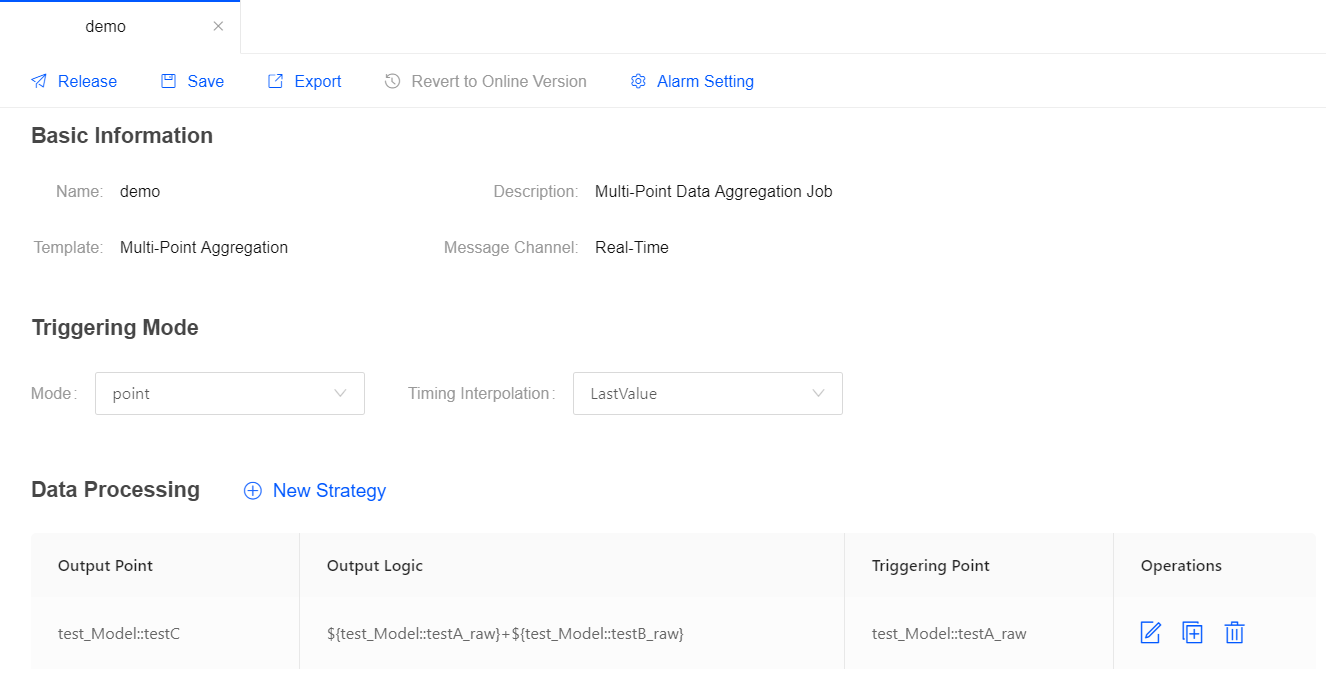Configuring a Multi-Point Data Calculation Job¶
Use the Multi-Point Merging template to quickly create a stream processing job for calculating data of multiple measuring points and assigning the processed data to another measuring point on the same device, by writing customized calculation expressions.
Setting Triggering Mode¶
The Multi-Point Merging template currently supports triggering data processing by a measuring point or by fixed frequency.
In the Triggering Mode section, set the triggering mode for the stream processing job.
Triggering by point
From the Mode drop down list, select point, and then from the Timing Interpolation drop down list, select LastValue.
Each time when the data of the triggering point arrives, the data processing task will be triggered. The data time stamp of the triggering point will be used as the time stamp of the output record.
If the data of a measuring point does not arrive when a data processing task is triggered, the latest data record of the measuring point will be used for calculation. This is how Timing Interpolation works.
Triggering by frequency
From the Mode drop down list, select frequency, and then from the Triggering Frequency drop down list, select a frequency value.
The data processing job will be triggered by the specified frequency. The system time of EnOS stream processing engine is used for controlling the trigger.
Configuring Data Processing Policy¶
In the Data Processing section, click New Strategy to configure the data processing policy in the pop-up window.
When the triggering mode is “point”, the configuration of a data processing policy record is as follows:
From the Output Point drop down list, select the measuring point that receives the output value of the data processing expression. Supported data types include int, float, string, and bool (other types will be converted to string).
From the Triggering Point drop down list, select the measuring point that triggers the data processing strategy.
In the Output Logic field, type the data processing expression. For supported syntax of the expression, see Multi-Point Merging Expression Syntax.
Click Check Syntax to verify the entered data processing expression.
Click OK to complete the configuration.
Note
The triggering point, output point, and the measuring points and attributes used in the data processing expression must belong to the same model. The triggering point cannot be the output point.
When the triggering mode is “frequency”, the configuration of a data processing policy record is as follows:
- From the Output Point drop down list, select the measuring point that receives the output value of the data processing expression. Supported data types include int, float, string, and bool (other types will be converted to string).
- In the Output Logic field, type the data processing expression. For supported syntax of the expression, see Multi-Point Merging Expression Syntax.
- Click Check Syntax to verify the entered data processing expression.
- Click OK to complete the configuration.
